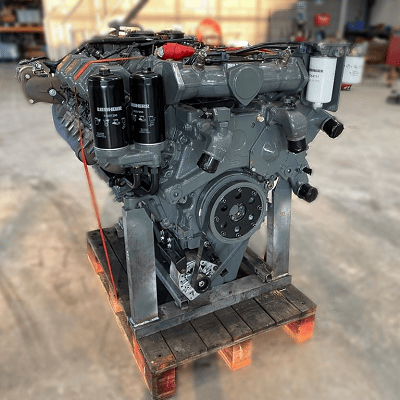The process of a dyno test on a Liebherr engine

When it comes to heavy machinery, reliability and power are paramount. Liebherr, a name synonymous with innovation and excellence in engineering, stands tall as a pioneer in the realm of heavy equipment and machinery. From towering cranes to robust excavators, Liebherr’s engineering prowess extends to the heart of these machines. We delve into the world of dyno testing a Liebherr engine, uncovering the meticulous process behind unleashing the raw power concealed within.
The foundation of excellence
Before we embark on the journey of dyno testing, it’s crucial to understand the foundation upon which Liebherr engines are built. With decades of engineering expertise and commitment to quality, Liebherr engines are crafted to withstand the most demanding environment and deliver unparalleled performance. Each component is meticulously designed and rigorously tested to ensure reliability, efficiency and longevity.
The process
1 Preparation: The engine undergoes meticulous preparation before being mounted onto the dynamo meter. This includes ensuring all connections are secure, fluids are filled to the appropriate levels, and sensors are properly calibrated.
2 Mounting: The engine is carefully mounted onto the dynamometer, a specialized device designed to simulate real-world operating conditions. Precision is paramount during this step to ensure accurate results.
3 Initial checks: Once mounted, a series of initial checks are conducted to verify proper alignment, connection integrity, and functionality of all engine systems.
4 Warm-up: The engine is started and allowed to warm up to operating temperature. This ensures consistent results and minimizes the risk of damage during testing.
5 Baseline testing: With the engine warmed up , baseline tests are conducted to establish initial performance metrics. This includes measuring power output, torque, fuel consumption, and emissions at various RPM levels.
6 Load testing: The engine is subjected to progressively increasing loads to simulate different operating conditions, such as idle, partial load and full load. This allows engineers to assess performance across the entire operating range and identify any potential issues or optimization.
7 Data analysis: Throughout the testing process, data is continuously collected and analyzed in real-time. Advanced instrumentation and software are used to monitor performance metrics and identify trends or anomalies.
8 Optimazation: Based on the data analysis, adjustments may be made to optimize engine performance. This could involve fine-tuning fuel injection timing, adjusting air-fuel ratios, or optimize turbocharger boost pressure.
9 Validation: Once testing is complete, the results are meticulously reviewed and validated against predetermined criteria and specifications. Any deviations or anomalies are thoroughly investigated to ensure accuracy and reliability.
10 Reporting: Finally, a comprehensive report is generated detailing the results of the dyno testing, including performance metrics, observations, and any recommendations for further optimization or refinement.
The outcome of dyno testing
Dyno testing a Liebherr engine is more than just a routine procedure – it’s a testament to the unwavering commitment to excellence that defines Liebherr’s engineering philosophy. By subjecting their engines to rigorous testing and analysis, Liebherr ensures that each engine delivers the uncompromising performance, reliability, and efficiency that customers expect.
In conclusion, dyno testing a Liebherr engine is not just about measuring power output. It’s about unlocking the true potential of these remarkable engines and ensuring they exceed expectations in the most challenging environments imaginable.
Casing is a large-diameter pipe that serves as the structural retainer for the walls of oil and gas wells or wellbore.
It is inserted into a well bore and cemented in place to protect both subsurface formations and the wellbore from collapsing and to allow
drilling fluid to circulate and extraction to take place
The oil casing is a steel pipe used to support the well wall of oil and gas wells to ensure the normal operation of the whole well during drilling and after well completion. Several layers of casing shall be used for each well according to different drilling depth and geological conditions. Cement shall be used for cementing after casing is put into the well. It is different from TUBING and drill pipe and cannot be reused. It is a disposable consumable material. Therefore, casing consumption accounts for more than 70% of all oil well pipes.
Casing is a large-diameter pipe that serves as the structural retainer for the walls of oil and gas wells, or wellbore. It is inserted into a well bore and cemented in place to protect both subsurface formations and the wellbore from collapsing and to allow drilling fluid to circulate and extraction to take place.
Surface casing
- Protects the well from contamination in shallow water and gas layers.
- Supports the wellhead equipment and sustains the weight of the other layers of casing.
Intermediate casing
- Isolates different layers of pressure to facilitate normal circulation of drilling fluid and protect the production casing.
- Intermediate casing facilitates the installation of blow-out preventers, anti-leakage devices and tailpipes in the well.
Production casing (oil string)
- It is the conduit through which oil and gas pass from a below surface reservoir.
- It protects the well and separates fluids into various layers.
First, green pipes are threaded on each end. The threading is then inspected and, if necessary, rethreaded to ensure that the thread accurately connects to the coupling. The threading type includes STC/BTC/LTC. The casing pipes are strengthened by surface treatment and are subject to various inspections, including drifting and hydrostatic tests before they are coated and packaged into casing.
Casing pipes are ordinarily produced with outside diameter sizes of 114.3 mm to 508.0 mm.
Casing,Api 5Ct Casing,Api Spec 5Ct Casing PipeApi 5Ct Pipe Oil Casing
ESASTSUN OILFIELD EQUIPMENT MANUFACTURING (CAMBODIA) CO., LTD , https://www.eastsuncambodia.com